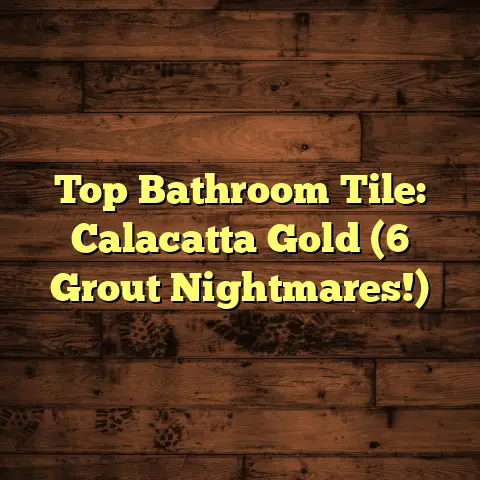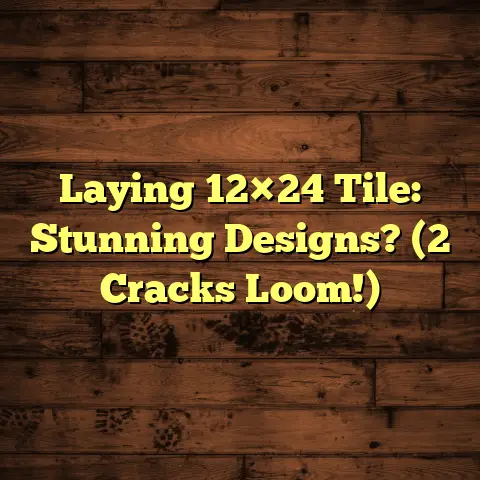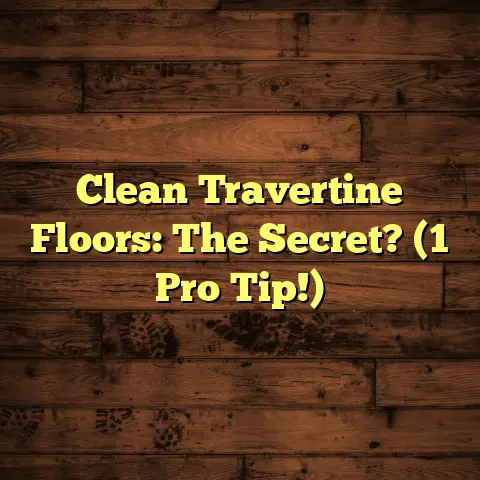Glue Vinyl Plank Flooring? (2 Install Secrets!)
If you’re looking to spruce up your home without emptying your wallet, this might just be the perfect solution.
Trust me, I’ve seen it all in my years of laying floors, and I’m here to share some insider secrets that’ll make your next project a breeze.
Let’s get started!
Section 1: Understanding Glue Vinyl
Plank Flooring
So, what exactly is glue vinyl plank flooring?
Well, unlike floating or click-lock systems, these planks are directly adhered to the subfloor using, you guessed it, glue!
Think of it as a more permanent, stable solution.
Composition:
These planks are made up of several layers:
-
Wear Layer: This is the top layer that protects against scratches, stains, and wear. The thicker the wear layer, the more durable the plank.
I generally recommend a wear layer of at least 12 mils (that’s 0.012 inches) for residential use.
-
Vinyl Layer: This layer provides the design and visual appeal.
-
Core Layer: This is the main body of the plank, providing stability and thickness.
-
Backing Layer: This bottom layer provides support and helps the plank adhere to the adhesive.
The materials used can vary, but most planks are made from PVC (polyvinyl chloride) or a composite material.
Styles, Colors, and Textures:
One of the best things about vinyl plank flooring is the sheer variety available.
You can find planks that mimic hardwood, stone, tile, and even concrete.
The textures can range from smooth to heavily embossed, adding realism and depth.
I’ve seen some incredible faux wood finishes that can fool even the most discerning eyes!
Section 2: The Benefits of Glue Down
Installation
Why choose glue-down over other installation methods?
Here’s the lowdown:
-
Superior Stability: Because the planks are glued directly to the subfloor, they’re incredibly stable and less likely to shift or move over time.
-
Reduced Movement: Floating floors can sometimes have a slight “give” underfoot. Glue-down eliminates this, providing a solid, comfortable feel.
-
Noise Reduction: The adhesive layer helps dampen sound, making it a quieter flooring option.
-
Suitable for Various Subfloors: Glue-down works well on concrete, plywood, and even existing tile, as long as the surface is properly prepared.
-
High-Moisture Areas: This is a big one! Glue-down is ideal for kitchens, bathrooms, and basements because it creates a moisture-resistant barrier.
With proper sealing, you can minimize the risk of water damage.
Homeowner Testimonials:
I’ve worked with countless homeowners who have chosen glue-down vinyl, and the feedback is overwhelmingly positive.
For example, a client of mine, Sarah, installed glue-down vinyl in her basement.
She was concerned about moisture, but after a year, she hasn’t had any issues.
She loves the look and feel of the floor, and it’s been a game-changer for her family.
Another client, Mark, installed it in his kitchen and raves about how easy it is to clean and maintain.
Section 3: Preparation for Installation
Alright, let’s talk prep work. This is crucial for a successful glue-down installation.
-
Measuring the Space: Accurate measurements are key. Measure the length and width of the room, and then multiply to calculate the square footage.
Add an extra 5-10% for waste and cuts.
-
Selecting the Right Vinyl Planks: Consider the wear layer, style, and color.
Also, check the manufacturer’s recommendations for adhesive compatibility.
-
Gathering Tools and Materials: You’ll need:
- Vinyl planks
- Adhesive
- Trowel (check the adhesive manufacturer’s recommendations for the correct notch size)
- Measuring tape
- Utility knife
- Straight edge
- Spacers
- Roller
- Cleaning supplies
Acclimation:
This is a step you cannot skip.
Vinyl planks need to acclimate to the room’s temperature and humidity for at least 48-72 hours before installation.
The ideal temperature range is typically between 65-85°F (18-29°C), and the humidity should be between 30-60%.
Subfloor Preparation:
The subfloor needs to be clean, level, and dry.
-
Cleaning: Sweep, vacuum, and mop the subfloor to remove any dust, debris, or contaminants.
-
Leveling: Use a self-leveling compound to fill in any cracks or imperfections.
A level subfloor is essential for a smooth, even installation.
-
Moisture Testing: Moisture is the enemy of glue-down vinyl.
Use a moisture meter to check the moisture levels in the subfloor.
For concrete, the moisture content should be below 4%. For wood, it should be below 12%.
If the moisture levels are too high, you’ll need to address the issue before proceeding.
Section 4: The Two Installation Secrets
Okay, now for the juicy stuff! Here are two secrets that will take your glue-down vinyl installation from amateur to pro:
Secret 1: Adhesive Application Techniques
Choosing the right adhesive is just as important as choosing the right planks.
Types of Adhesives:
-
Acrylic Adhesives: These are water-based and low in VOCs (volatile organic compounds), making them a more eco-friendly option.
-
Epoxy Adhesives: These are stronger and more durable, but they can be more difficult to work with and have higher VOC levels.
-
Polyurethane Adhesives: These offer a good balance of strength and flexibility, and they’re resistant to moisture.
Always check the adhesive manufacturer’s recommendations to ensure it’s compatible with your vinyl planks and subfloor.
Best Practices for Applying Adhesive:
-
Use a Trowel: A notched trowel is essential for applying an even coat of adhesive. The notch size will depend on the adhesive and the manufacturer’s recommendations.
Typically, a 1/16″ x 1/16″ x 1/16″ or 1/8″ x 1/8″ x 1/8″ V-notch trowel is suitable for most vinyl plank installations.
-
Spread Rate: Follow the manufacturer’s recommended spread rate. This is usually expressed in square feet per gallon.
Applying too much or too little adhesive can cause problems.
-
Even Coat: Apply the adhesive in a consistent, even coat. Avoid puddles or thin spots.
-
Open Time: Pay attention to the adhesive’s open time, which is the amount of time you have to lay the planks after applying the adhesive.
If you wait too long, the adhesive will start to dry and won’t bond properly.
Visual Aids:
Imagine you’re spreading peanut butter on toast. You want an even layer, not too thick, not too thin.
The trowel helps you achieve this with the adhesive.
Hold the trowel at a 45-degree angle and apply firm, even pressure.
Secret 2: Plank Placement and Alignment
Planning your layout is key to a professional-looking installation.
Planning the Layout:
-
Starting Point: Find the center of the room and start your first row of planks along a chalk line.
-
Plank Direction: Decide whether you want to lay the planks parallel or perpendicular to the longest wall.
This can affect the look and feel of the room.
-
Staggering Seams: Stagger the seams between rows to create a more natural, visually appealing look.
A good rule of thumb is to stagger the seams by at least 6 inches.
Ensuring Accurate Alignment and Spacing:
-
Spacers: Use spacers along the walls to maintain a consistent gap. This allows for expansion and contraction.
-
Proper Tools: A utility knife and straight edge are essential for making clean, accurate cuts.
-
Rolling: After laying each row of planks, use a roller to press them firmly into the adhesive.
This ensures a strong bond and eliminates air pockets.
Common Pitfalls to Avoid:
-
Misalignment: Double-check the alignment of each plank before pressing it into the adhesive.
-
Gaps: Avoid gaps between planks. Use a tapping block and hammer to gently nudge them together.
-
Adhesive Squeeze-Out: If adhesive squeezes out between the planks, wipe it away immediately with a damp cloth.
Section 5: Finishing Touches and Maintenance
You’re almost there! Now for the finishing touches:
-
Trimming Edges: Use a utility knife to trim any excess vinyl along the walls.
-
Installing Baseboards: Install baseboards to cover the spacers and create a finished look.
-
Cleaning: Clean the newly laid floor with a damp mop and a mild detergent.
Maintenance Tips:
-
Regular Cleaning: Sweep or vacuum regularly to remove dirt and debris.
-
Damp Mopping: Mop with a damp mop and a mild detergent as needed.
-
Protective Measures: Use floor protectors under furniture legs to prevent scratches.
-
Avoid Harsh Chemicals: Avoid using harsh chemicals or abrasive cleaners, as they can damage the vinyl.
Potential Repairs:
-
Scratches: Minor scratches can often be buffed out with a scratch repair kit.
-
Damaged Planks: If a plank is severely damaged, you can replace it.
Carefully cut around the damaged plank with a utility knife and remove it.
Then, clean the area and glue down a new plank.
Conclusion
So, there you have it! Glue vinyl plank flooring is a fantastic option for homeowners looking for an affordable, durable, and stylish flooring solution.
With proper preparation and installation techniques, you can achieve professional-looking results that will enhance your living spaces for years to come.
Remember those two installation secrets: adhesive application and plank placement.
Master these, and you’ll be well on your way to a beautiful, long-lasting floor.
Now go out there and get flooring!





